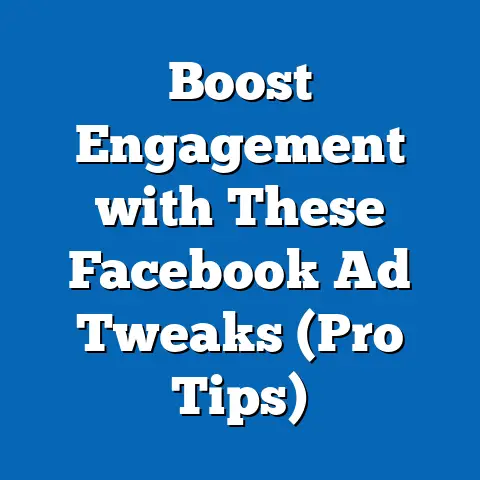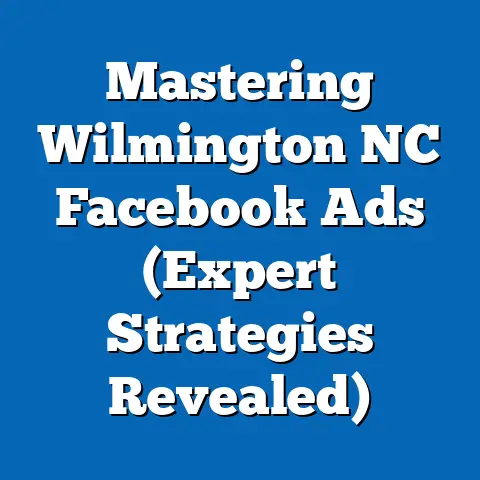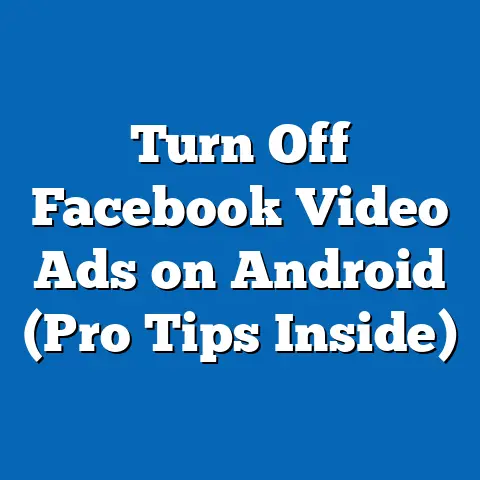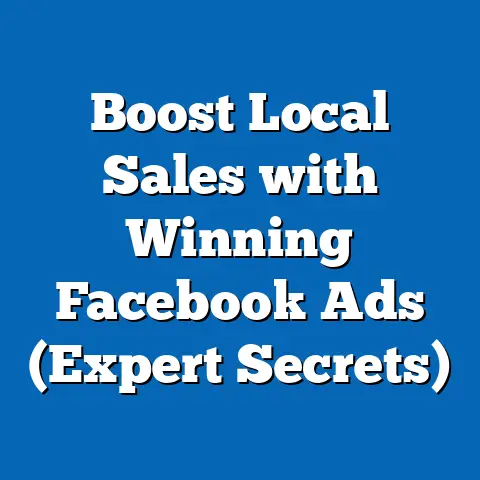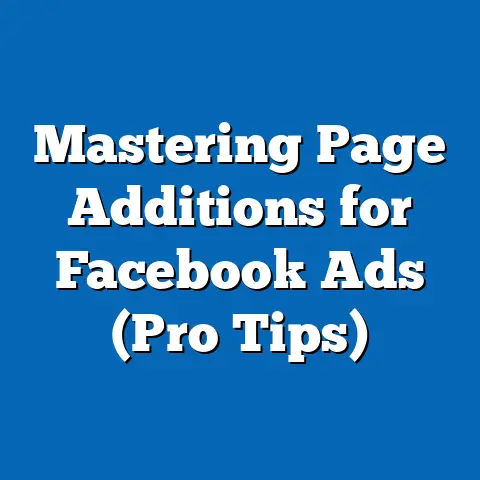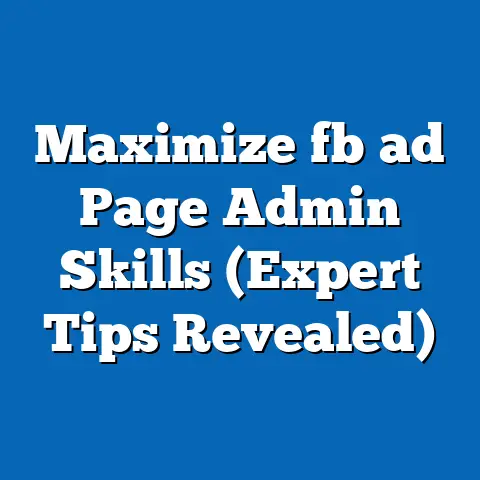Maximize Impact with Single Facebook Ads (Proven Strategies)
The world of Facebook advertising is a vast and ever-changing landscape. It can feel overwhelming, especially when you’re trying to cut through the noise and connect with your target audience. I’ve been there, spending countless hours tweaking campaigns, analyzing data, and trying to figure out what truly works. One thing I’ve learned is that sometimes, less is more. Focusing on a single, powerful Facebook ad can often be more effective than spreading your efforts across multiple variations.
Think about it: how often do you scroll through your Facebook feed, bombarded with ads? It’s easy to become immune to the constant stream of promotions. But what if you could create an ad so compelling, so perfectly targeted, that it stops people in their tracks? What if that single ad could drive significant engagement, boost brand awareness, and ultimately, increase your sales?
That’s the power of a well-crafted single Facebook ad. In this article, I’m going to share proven strategies to help you maximize the impact of your single Facebook ads. We’ll dive into crafting compelling messages, selecting impactful visuals, targeting the right audience, and optimizing for performance. By the end, you’ll have the knowledge and tools you need to create ads that truly resonate with your audience and deliver real results.
Understanding the Power of Single Facebook Ads
So, what exactly is a single Facebook ad, and why should you consider focusing on it? Simply put, a single Facebook ad is a standalone advertisement that you create and promote on the platform. It’s different from a multi-ad campaign, where you might run several variations of an ad with different headlines, images, or targeting options.
The beauty of a single Facebook ad lies in its simplicity and focus. When you concentrate your efforts on perfecting one ad, you can:
- Craft a clearer message: Instead of diluting your message across multiple ads, you can hone in on the single most compelling benefit you offer.
- Reduce cognitive load for your audience: A single, well-designed ad is easier for people to process and remember than a barrage of different messages.
- Improve targeting: By focusing on one ad, you can refine your targeting to reach the audience most likely to respond to your message.
I remember working with a local bakery that was struggling to attract new customers. They were running multiple Facebook ads with different offers and targeting options, but none of them seemed to be performing well. After analyzing their data, I suggested they focus on a single ad showcasing their signature cake, with a clear call to action to order online. We refined the targeting to reach people interested in baking, desserts, and local events. The result? A significant increase in online orders and a noticeable boost in foot traffic to their bakery. It was a testament to the power of focusing on a single, well-executed ad.
According to recent data, businesses that concentrate their ad spend on a few high-performing ads see an average of 20% higher conversion rates compared to those that spread their budget across numerous ads. This is because a focused approach allows for more precise targeting and refined messaging, leading to better engagement and ultimately, more conversions.
Key Takeaway: Single Facebook ads offer a powerful way to connect with your audience by focusing your message, improving targeting, and reducing cognitive overload.
Crafting a Compelling Message
The heart of any successful Facebook ad is its message. It’s what grabs attention, sparks interest, and motivates people to take action. But crafting a compelling message isn’t just about writing catchy slogans. It’s about understanding your audience, knowing their needs and desires, and communicating how your product or service can solve their problems.
Here are some key elements to consider when crafting your ad copy:
- Clear and Concise Headlines: Your headline is the first thing people see, so it needs to be attention-grabbing and instantly convey the value you offer. Keep it short, sweet, and relevant to your target audience.
- Relatable and Emotionally-Driven Messaging: People connect with stories and emotions, not just facts and figures. Use relatable language and imagery to create an emotional connection with your audience. Show them how your product or service can make their lives better, easier, or more enjoyable.
- Persuasive Language: Use language that emphasizes the benefits of your product or service, not just its features. Highlight the positive outcomes people can expect, and use strong verbs and adjectives to create a sense of excitement and urgency.
Let’s look at an example. Imagine you’re advertising a fitness app that helps people lose weight. Instead of simply saying “Our app helps you lose weight,” you could try something like this:
“Tired of feeling sluggish and unhappy with your body? Our fitness app provides personalized workout plans and expert nutrition guidance to help you achieve your weight loss goals. Imagine feeling confident, energetic, and ready to take on the world! Download our app today and start your transformation!”
“Tired of feeling sluggish and unhappy with your body? Our fitness app provides personalized workout plans and expert nutrition guidance to help you achieve your weight loss goals. Imagine feeling confident, energetic, and ready to take on the world! Download our app today and start your transformation!”
Notice how this ad copy focuses on the emotional benefits of weight loss, such as feeling confident and energetic. It also uses persuasive language like “transformation” and “ready to take on the world” to create a sense of excitement and possibility.
I once worked with a local therapist who was struggling to attract new clients. Her initial ad copy was very clinical and focused on her qualifications and experience. After talking to her and understanding her approach, I realized she was all about creating a safe and supportive space for her clients. We rewrote her ad copy to reflect this, using language that was warm, inviting, and empathetic. The result was a significant increase in inquiries and a much better connection with her target audience.
Key Takeaway: Crafting a compelling message requires understanding your audience, focusing on the benefits you offer, and using language that is both persuasive and emotionally resonant.
Visual Elements that Enhance Impact
In the visually-driven world of Facebook, your ad’s image or video is just as important as the copy. It’s what initially grabs attention and creates a lasting impression. The right visual can instantly convey your message, evoke emotions, and motivate people to click.
Here are some best practices for selecting visuals for your Facebook ads:
- Choose High-Quality, Relevant Visuals: Avoid blurry, pixelated, or generic images. Use visuals that are clear, sharp, and directly related to your product or service.
- Resonate with Your Target Audience: Consider the demographics, interests, and values of your target audience when selecting visuals. Choose images or videos that they will find appealing and relatable.
- Incorporate Infographics or Data Visualizations: If you have data or statistics that support your message, consider using infographics or data visualizations to present them in a visually appealing way.
For example, if you’re advertising a travel agency, you might use stunning photos of exotic destinations or videos showcasing the experiences people can have on your tours. If you’re advertising a software product, you might use screenshots of the user interface or videos demonstrating how the product works.
I remember seeing an ad for a local animal shelter that used a simple but powerful image of a rescued dog looking directly at the camera. The dog’s eyes were filled with hope and gratitude, and the ad copy simply asked people to consider adopting a pet. The ad was incredibly effective, and the shelter saw a significant increase in adoptions in the following weeks.
Key Takeaway: Visuals are a crucial element of Facebook ads. Choose high-quality, relevant visuals that resonate with your target audience and effectively convey your message.
Targeting the Right Audience
Even the most compelling message and stunning visuals will fall flat if you’re not reaching the right audience. Facebook’s targeting options allow you to pinpoint the people most likely to be interested in your product or service, ensuring that your ad dollars are spent effectively.
Facebook offers a wide range of targeting options, including:
- Demographics: Target people based on age, gender, location, education, job title, and more.
- Interests: Target people based on their interests, hobbies, and activities.
- Behaviors: Target people based on their online behavior, such as their purchase history, device usage, and travel habits.
- Custom Audiences: Create custom audiences based on your existing customer data, website traffic, or app activity.
- Lookalike Audiences: Reach new customers who are similar to your existing customers.
The key to effective targeting is to understand your ideal customer. Who are they? What are their interests? What problems are they trying to solve? Once you have a clear picture of your target audience, you can use Facebook’s targeting options to reach them with your ads.
I worked with a small online retailer that sold organic baby clothes. Initially, they were targeting a broad audience of parents, but their ads weren’t performing well. After analyzing their customer data, I realized that their ideal customer was a millennial mom who was passionate about sustainability and ethical fashion. We refined their targeting to reach this specific audience, and their ad performance skyrocketed.
Key Takeaway: Effective audience targeting is essential for maximizing the impact of your Facebook ads. Understand your ideal customer and use Facebook’s targeting options to reach them with your message.
Optimizing for Performance
Creating a great Facebook ad is just the first step. To truly maximize its impact, you need to continuously monitor its performance and make adjustments as needed. This is where ad optimization comes in.
Ad optimization involves:
- A/B Testing: Experiment with different ad copies, visuals, and targeting options to see what resonates best with your audience.
- Monitoring Key Performance Indicators (KPIs): Track metrics like click-through rates (CTR), engagement rates, conversion rates, and cost per acquisition (CPA) to understand how your ads are performing.
- Making Data-Driven Adjustments: Use the data you collect to make informed decisions about how to improve your ad performance.
For example, if you notice that your CTR is low, you might try tweaking your headline or image to make it more attention-grabbing. If your CPA is high, you might try refining your targeting or adjusting your bidding strategy.
I once ran an A/B test for a client that was advertising a new line of skincare products. We created two versions of the ad, one with a photo of a model using the product and one with a video demonstrating the product’s benefits. The video ad significantly outperformed the photo ad, so we decided to focus our budget on the video ad and saw a dramatic increase in sales.
Key Takeaway: Ad optimization is an ongoing process that involves A/B testing, monitoring KPIs, and making data-driven adjustments to improve your ad performance.
Utilizing Facebook’s Ad Tools and Features
Facebook offers a variety of tools and features that can help you enhance the effectiveness of your single ads. Here are a few key ones to consider:
- Facebook Pixel: The Facebook Pixel is a small piece of code that you can install on your website to track conversions, build custom audiences, and optimize your ads.
- Lookalike Audiences: Lookalike audiences allow you to reach new customers who are similar to your existing customers, expanding your reach and driving more conversions.
- Retargeting: Retargeting allows you to re-engage users who have previously interacted with your website or app, reminding them of your product or service and encouraging them to take action.
By leveraging these tools and features, you can create more targeted, personalized, and effective Facebook ads.
I’ve personally seen the power of retargeting. I was browsing a website for a new camera lens, but didn’t make a purchase. For the next few days, I saw ads for that lens on Facebook, reminding me of my interest. Eventually, I clicked on the ad and made the purchase. It was a classic example of how retargeting can nudge potential customers towards conversion.
Key Takeaway: Facebook offers a range of powerful tools and features that can help you enhance the effectiveness of your single ads. Utilize the Facebook Pixel, Lookalike Audiences, and Retargeting to create more targeted and personalized ads.
Conclusion
Mastering the art of the single Facebook ad is a journey, not a destination. It requires a deep understanding of your audience, a compelling message, stunning visuals, precise targeting, and continuous optimization. But the rewards are well worth the effort. By focusing your efforts on a single, powerful ad, you can cut through the noise, connect with your target audience, and drive real results for your business.
Remember, the key is to start with a clear goal, understand your audience, and continuously test and refine your approach. Don’t be afraid to experiment and try new things. The world of Facebook advertising is constantly evolving, so it’s important to stay up-to-date on the latest trends and best practices.
Now, it’s time to put these strategies into action. Start crafting your single Facebook ad today, and get ready to see the impact it can have on your business.

